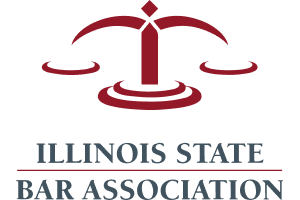- 24/7 Free Consultation: (888) 424-5757 Tap Here To Call Us
Chicago Nursing Home Burn Injury Attorney

Compensation for Victims of Burns and Scalds in Chicago Nursing Homes
Chicago nursing home burn injury attorney representation is vital when an elderly resident suffers preventable burn injuries in a care facility.
Nursing home residents sustain an average of 108 injuries due to fires each year. When a person living in an assisted living facility suffers burn injuries due to negligence, a Chicago nursing home abuse and neglect attorney can help protect their rights and pursue justice.
Threat of Burn Injuries in Chicago Nursing Facilities
Burn injuries are particularly dangerous for elderly people. Thinner, more fragile skin tears easily, and thermal damage penetrates deeper. Healing is slower, and the risk of deadly infections, fluid loss, and complications rises dramatically.
Even relatively small burns can lead to severe pain, permanent disability, or death. A single oversight by staff can cause injuries that alter a patient’s quality of life forever.
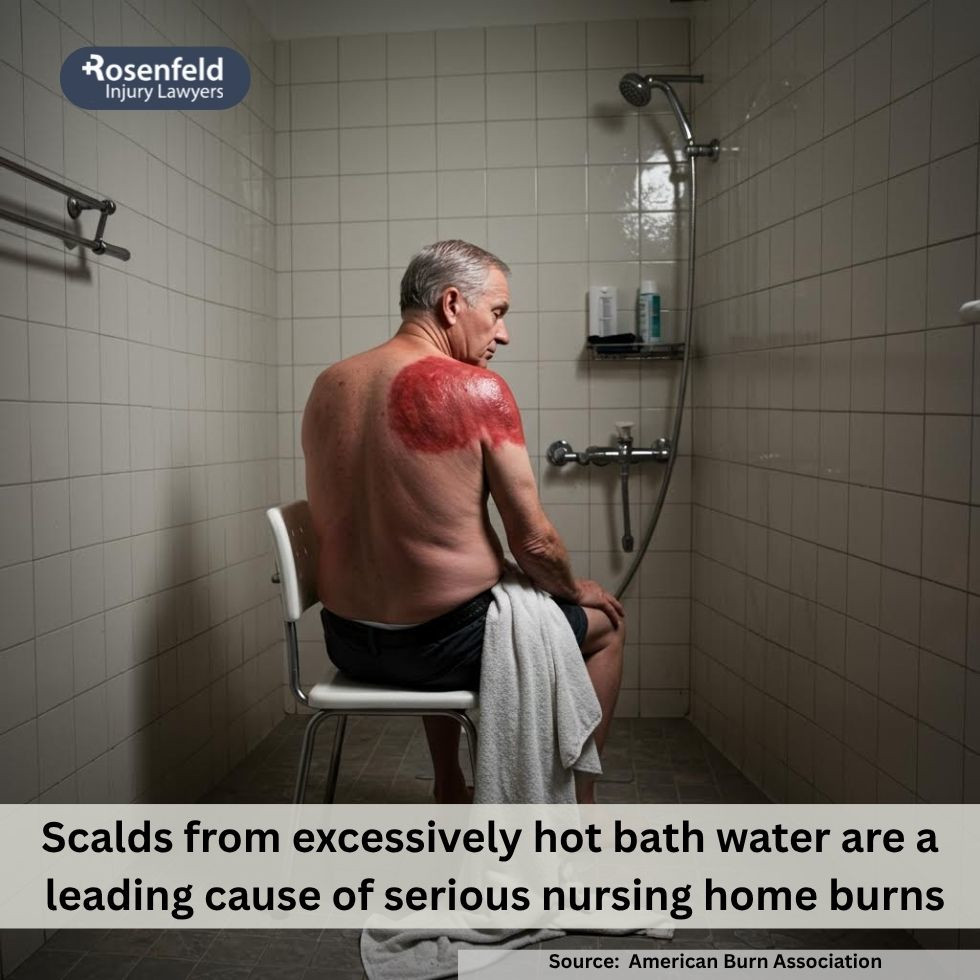
How Do Burn Injuries Happen in Care Facilities?
Living in an elder care environment should provide safety, stability, and proper oversight. Yet when facilities cut corners or staff members fail to follow safety protocols, dangerous conditions can quickly put vulnerable individuals at risk.
Thermal injuries are alarmingly common in these settings and often stem from simple hazards that would have been preventable with appropriate care and attention.
Various everyday activities and facility systems can expose individuals to serious harm if not properly managed. Some of the most frequent sources include:
- Scalding water from improperly monitored baths or showers or spills from hot beverages.
- Contact burns from touching hot radiators, heating pipes, kitchen equipment, or food service trays.
- Smoking-related fires when older adults who smoke are left unsupervised or improperly monitored.
- Chemical burns caused by mishandling or poor storage of cleaning supplies.
- Electrical burns due to faulty beds, lifts, or patient-used appliances.
When staff fail to monitor older adults in assisted living programs properly or facilities neglect equipment maintenance, serious burn injuries are often the result.
Burn Severity: Degrees of Damage
Burn injuries in senior care centers are categorized based on how deeply they damage the skin and underlying tissue. Even relatively small burns can have devastating consequences for elderly residents, especially when compounded by slow healing and increased risk of infection.
In some cases, severe burns can ultimately lead to wrongful death if complications become unmanageable.
First-Degree Burns
First-degree burns affect only the outermost layer of the skin, known as the epidermis. These injuries often resemble sunburn, leading to redness, mild swelling, and discomfort. Although first-degree ones are considered the least severe, they still require attention in older adults due to the risk of skin breakdown, infection, and delayed healing.
Second-Degree Burns
Second-degree burns penetrate deeper into the skin, affecting both the epidermis and the underlying dermis. These injuries typically cause blistering, significant redness, and sharp, persistent pain.
In elderly patients, second-degree burns often take longer to heal and carry a high risk of infection. Large second-degree burns covering sensitive areas of the body can also result in permanent scarring and reduced mobility.
Third-Degree Burns
Third-degree burns are among the most serious types of burn injuries that can occur in assisted living facilities. These injuries destroy all layers of the skin and may damage underlying fat, muscle, or even bone. Affected areas often appear white, leathery, or charred, and senior citizens may initially experience little to no pain due to nerve damage.
Third-degree burns almost always require extensive medical treatment, including surgeries, skin grafts, and long-term rehabilitation. In elderly people with fragile health, third-degree burns dramatically increase the risk of deadly infections, organ failure, and wrongful death.
Fourth-Degree Burns
Fourth-degree burns represent the most catastrophic level of injury. These burns extend beyond the skin into muscles, tendons, and bones. Fourth-degree burns often result in a lasting impairment, amputation, or death. Nursing home residents suffering such severe burns require intensive medical care and are usually left with life-altering consequences if they survive.
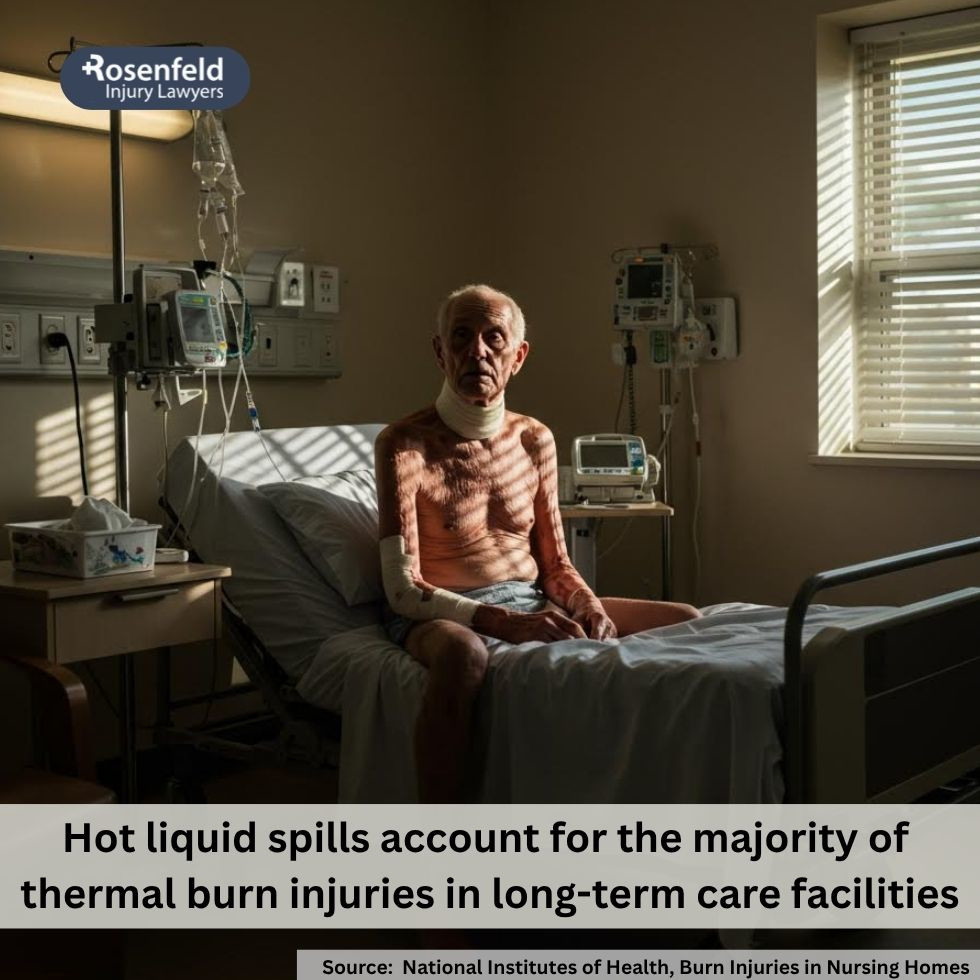
Symptoms of Different Burn Injury Types
Recognizing the severity of damage early is vital. Common symptoms include:
- Redness and swelling (first-degree)
- Blistering and severe pain (second-degree)
- White or blackened skin and possible numbness due to nerve damage (third-degree)
- Charred tissue and visible damage to underlying muscle or bone (fourth-degree)
Pain levels may not always reflect severity, especially if nerves are damaged.
Common Causes Rooted in Nursing Home Negligence
Many devastating incidents in elder care centers are traced back to systemic problems with supervision, facility upkeep, or staff readiness. Without close monitoring, dangerous conditions can arise quickly, leading to harm that should have been preventable.
Inadequate Supervision Leading to Burn Injuries
Negligent supervision puts patients at direct risk. Allowing a known unsafe smoker to smoke without assistance or failing to help an occupant safely handle hot food and drinks can lead to serious burns. Seniors with mobility issues or cognitive impairments are especially vulnerable.
Failure to Maintain Safe Water Temperatures and Equipment
Facilities have a duty to maintain safe bathing and living conditions. Failing to install or monitor anti-scald devices, using malfunctioning heating equipment, and leaving chemicals improperly stored can all result in injuries. Poor maintenance creates hazards that endanger every patient.
Lack of Proper Staff Training and Safety Protocols
Without proper training, staff may not recognize the dangers seniors face. Safe bathing procedures, smoking policies, equipment handling, and emergency response must be part of every facility’s training. Neglecting these areas often leads to preventable burn injuries.
Life-Threatening Complications of Nursing Facility Burn Injuries
Thermal trauma can have devastating consequences for older adults living in long-term care facilities. What might initially appear to be a moderate wound can rapidly escalate into a cascade of life-threatening complications.
With thinner skin, reduced immune defenses, and slower healing times, older individuals are at far greater risk when exposed to extreme heat sources or hazardous environments. The aftermath of a severe thermal event often includes multiple medical challenges, including:
- Life-threatening infections and sepsis
- Severe fluid loss leading to dehydration
- Hypothermia
- Breathing difficulties from airway burns
- Disfigurement and permanent disability
Without rapid intervention and specialized care, these complications can lead to permanent declines in health, loss of mobility, or even death.
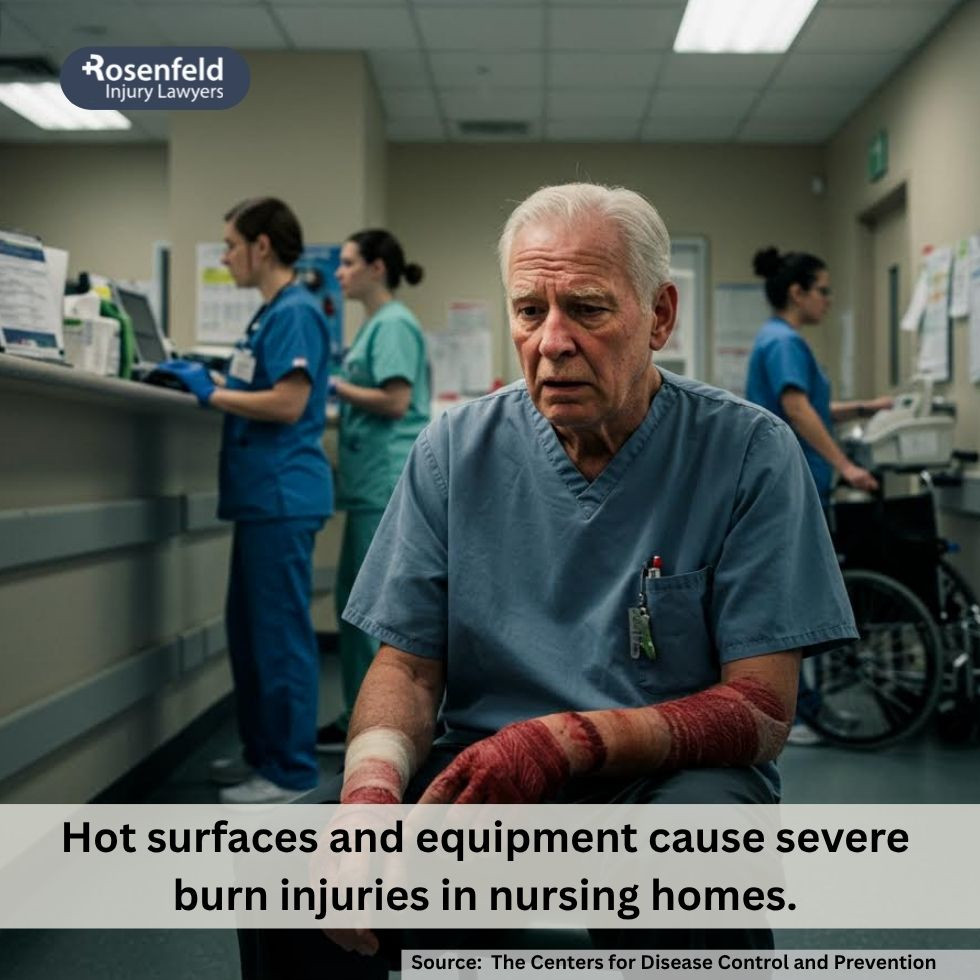
Long-Term Physical Consequences
Recovering from severe thermal trauma is only the beginning. Many older individuals who survive these events face a lifetime of difficult health challenges that affect both their bodies and their daily lives.
Even with expert treatment, healing is frequently incomplete, and lasting damage can reshape a person’s independence, comfort, and self-image. Some of the most common long-term consequences include:
- Permanent disfiguring scars
- Contractures that limit joint mobility
- Chronic pain and nerve damage
- The potential need for amputations in the worst cases
Long-term consequences not only impact the individual; they often require families to make difficult decisions about ongoing care, specialized therapy, and additional support services. Addressing these realities requires thoughtful planning, resources, and strong advocacy to protect the quality of life moving forward.
The Psychological Impact on Burn Injury Victims
The consequences of severe thermal trauma extend far beyond the visible scars. While bodily wounds may eventually heal, the emotional and psychological effects can last a lifetime.
Recovery often involves confronting not only the memory of the event itself but also the daily challenges and changes to appearance, mobility, and sense of independence. For many older adults, these internal battles can be even more difficult than the physiological recovery process.
Common emotional and psychological struggles include:
- Post-traumatic stress disorder (PTSD)
- Anxiety and depression
- Body image issues due to disfigurement
- Loss of independence
- Psychological effects of chronic pain
Regaining a sense of self and rebuilding emotional resilience can be a long and difficult journey. Recognizing the profound psychological toll is crucial when assessing the full impact of thermal trauma and when advocating for proper resources and support to aid recovery.
Holding the Nursing Facility Liable
When carelessness leads to a nursing home resident’s burn injuries, the facility can be held legally responsible. Facilities must protect their occupants, and failure to do so may open the door to legal action.
Residents’ Rights Under Illinois Law
The Illinois Nursing Home Care Act protects patients’ rights to safe living conditions, freedom from mistreatment, and proper care. Violations of this law provide a strong basis for holding facilities accountable after burn injuries.
Investigating the Cause of the Burn Injury
Uncovering how a serious thermal event occurred in a care facility requires a careful, thorough investigation. Simply relying on the facility’s explanation is never enough. Building a strong legal claim depends on digging into every detail, identifying breakdowns in care, and tracing how preventable hazards led to harm. Experienced legal teams will:
- Review patient records for documentation of injuries and treatment.
- Examine incident reports, maintenance logs, and safety records.
- Interview staff members, witnesses, and other members.
- Consult burn injury experts and safety engineers when needed.
Building a strong case requires understanding all factors that contributed to the injury.
Damages Available in Nursing Home Burn Injury Cases
When a vulnerable individual experiences severe harm in a long-term care setting, the effects ripple across every part of their life and often across the lives of their family members as well.
The financial, emotional, and bodily costs can be staggering. Pursuing a legal claim offers a way to seek justice and provide necessary resources for recovery, rehabilitation, and ongoing care needs. Through legal action, families may seek compensation for:
- Past and future healthcare costs, including surgeries, therapy, medications, and specialist care.
- Pain and suffering endured.
- Disfigurement damages.
- Long-term disability affecting quality of life.
- Related out-of-pocket expenses, such as specialized equipment or relocation to a higher-level care facility.
Personal injury cases seek to ease the financial and emotional burden on victims and their families.
Pursuing Wrongful Death Claims After Fatal Burn Injuries
If burn injuries or related complications result in a death, eligible family members can pursue a wrongful death lawsuit. Compensation can include:
- Funeral and burial expenses.
- Medical bills incurred before death.
- Loss of companionship, guidance, and emotional support.
- The person’s conscious pain and suffering prior to passing.
A wrongful death claim honors the dignity of your family member and holds responsible parties accountable.
Illinois Statute of Limitations for Your Claim
In Illinois, most personal injury claims and wrongful death cases must be filed within two years of the injury or death. Delaying legal action can jeopardize your right to seek compensation, so it’s vital to consult a personal injury attorney promptly.
Why Hire a Specialized Chicago Burn Injury Lawyer?
Burn injury cases against nursing facilities require legal expertise in both personal injury law and nursing home abuse litigation. An experienced lawyer knows how to:
- Identify breach of duty.
- Calculate long-term damages.
- Navigate complex facility regulations.
- Advocate effectively against insurance companies.
Our Law Firm’s Approach to Complex Burn Injury Cases
Our team is dedicated to helping seniors and families affected by serious burn injuries. We work with top medical experts, consult burn specialists, and fully investigate every aspect of a case. We are committed to holding negligent assisted living facilities accountable for the harm sustained.
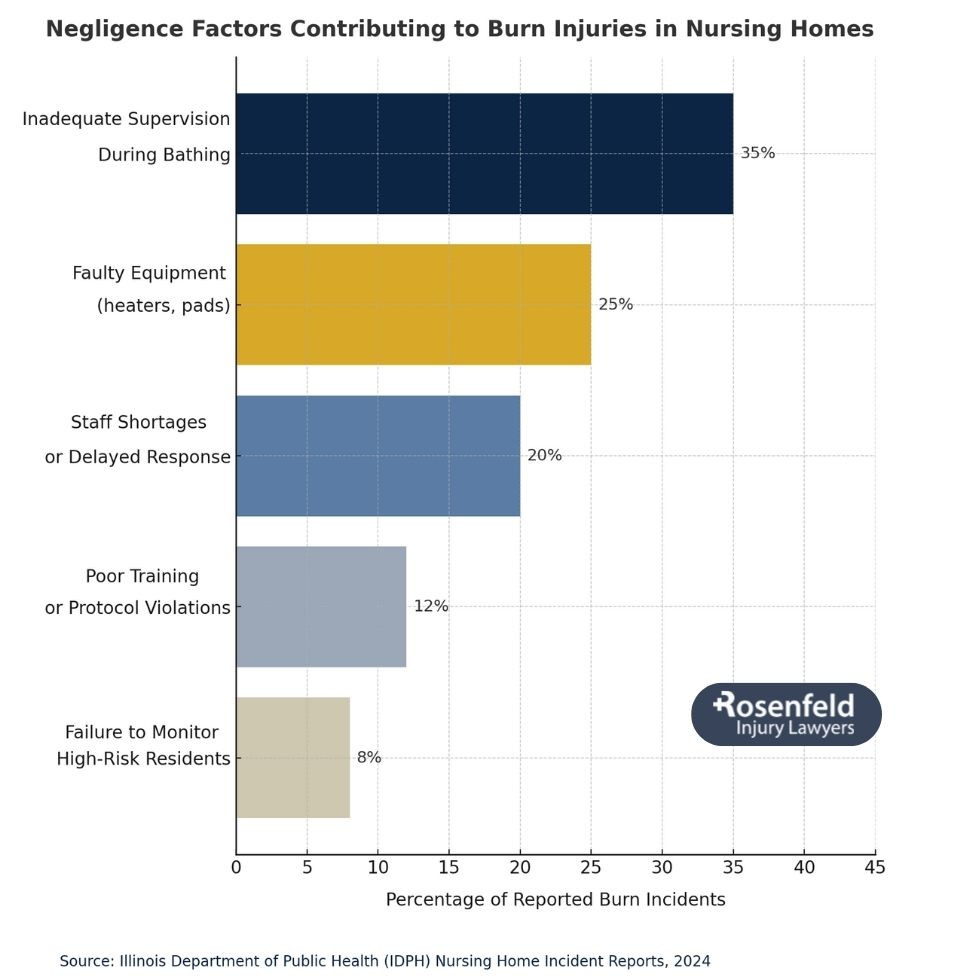
FAQs About Chicago Nursing Home Burn Cases
What Are the Most Common Negligent Acts Leading to Burns in Nursing Facilities?
The most common negligent acts include allowing unsafe smoking practices, failing to regulate water temperatures, improper handling of hot food and beverages, poor storage of chemicals, and failure to maintain safe electrical equipment. Staff neglect and facility maintenance failures frequently result in major trauma.
How Can Family Members Help Prove a Burn Injury Case Against a Nursing Center?
Family members can assist by:
- Documenting injuries with photos.
- Collecting and preserving medical records.
- Requesting copies of incident reports.
- Speaking with other members and staff.
- Retaining any communication from the facility related to the incident.
Gathering early evidence strengthens a case against negligent facilities.
What Is My Burn Injury Case Potentially Worth in a Settlement?
Settlement amounts vary depending on:
- The severity and extent of the injuries.
- Whether the person suffered long-term disability.
- The amount of medical care required.
- Pain, suffering, and emotional distress.
- Whether wrongful death occurred.
An experienced burn injury lawyer in Chicago can assess your specific circumstances and provide guidance on potential case value.
Can the Assisted Living Facility Blame the Patient for the Burn?
Facilities sometimes attempt to shift blame onto the victim. They may argue that the person acted against advice, failed to follow safety instructions, or engaged in risky behavior. However, nursing facilities have a legal duty to protect vulnerable older adults, even those who may be prone to risky behaviors. Failure to act properly on the part of the facility cannot be excused by blaming the victim.
Consult a Chicago Nursing Home Burn Injury Lawyer Near You!

If a loved one has experienced burn injuries in a Chicago senior care home, contact our firm today. Rosenfeld Injury Lawyers offer a free case evaluation to review your case, explain your legal options, and help you move forward. Call us today to schedule your consultation and protect your family’s future.
Call us today at (888) 424-5757 or through our contact form to schedule your free consultation.
All content undergoes thorough legal review by experienced attorneys, including Jonathan Rosenfeld. With 25 years of experience in personal injury law and over 100 years of combined legal expertise within our team, we ensure that every article is legally accurate, compliant, and reflects current legal standards.



